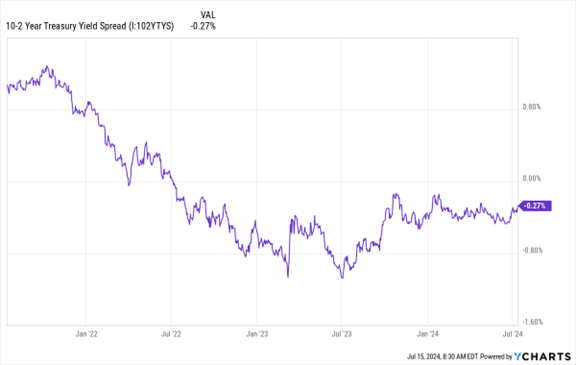Don’t look now. But one of the “recession indicators” that didn’t really pan out last year is now close to signaling “all clear.” I’m talking about the Treasury yield curve, or more specifically, the “2-10 Spread.”
Take a look at the MoneyShow Chart of the Week for July 15, 2024 below. It shows the difference in yield – or spread – between the 10-year Treasury Note and 2-year Treasury Note over the last three years.

Data by YCharts
Normally, the yield on a longer-term government bond is higher than the yield on a shorter-term one. The spread is positive. That’s because investors know there’s a greater chance of inflation eating away at their returns over, say, a 10-year term versus a 2-year one. So, they demand a yield premium to loan the government money over a longer period of time.
It’s just like how consumers pay higher rates on longer-term car loans than shorter-term ones. After all, banks know the chance that a customer defaults is higher during a 7-year loan term than a 3-year one.
But ahead of many recessions in US economic history, the yield curve has gone negative – or “inverted.” That’s because higher inflation late in an economic cycle forces the Federal Reserve to raise short-term rates, driving the 2-year yield higher. Simultaneously, it causes longer-term yields to fall as markets price in a higher chance Fed hikes NOW will crush growth and drive the economy into recession LATER.
In this cycle, that didn’t really happen. Yes, the curve inverted. And yes, we did technically have two quarters of negative GDP in early 2022. But we didn’t get a broad-based, textbook recession. The National Bureau of Economic Research (NBER), which is the widely accepted arbiter of these things, never declared one.
And now that it appears growth could pick back up at the same time the Fed could start cutting rates, we’re seeing the 2-10 spread rise. It has already climbed from minus-108 basis points last summer to only minus-27 now. It wouldn’t take much more to get us back above zero for the first time since summer 2022.
So, what does it all mean for investors and traders? Past periods of re-steepening have sometimes been accompanied by higher volatility and bearish market action. But that’s because the Fed went too far when it hiked, waited too long to start cutting, credit markets started to “blow up,” and so on. That doesn’t look to be the case this time around.
So from where I sit, this is simply confirmation of the soft-landing scenario. That means you “Stay Bold” in stocks and commodities, and keep getting more constructive in bonds.


















